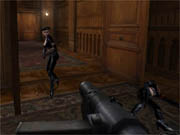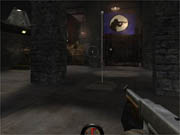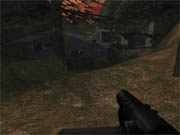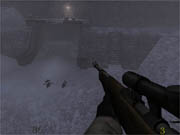As the year has worn on, and more and more big-name PC action games have slipped into 2002, Return to Castle Wolfenstein has emerged as the only triple-A shooter likely to be released in time for the 2001 holiday season. It certainly has a blockbuster pedigree. It's a sequel to Wolfenstein 3D--id Software's first-person shooter that defined the genre--which was itself a follow-up to the beloved Apple II classic Castle Wolfenstein. Return to Castle Wolfenstein's development actually involved two separate teams, both overseen by id Software. The first team, Gray Matter Studios--which, under the name Xatrix, had previously produced Redneck Rampage and Kingpin--was hired to create the single-player campaign, while a new development house, Nerve Software, concentrated its energies on the multiplayer component. All these factors contributed to some perhaps unreasonably heightened expectations. Now that the waiting is over and the game is out, it can be stated for the record that Wolfenstein's single-player mode is good. It's...good. It's pretty good. But with the faint-praise damning out of the way, you'll be happy to hear that the multiplayer game is outstanding.

Wolfenstein borrows much of its structure from No One Live Forever, last year's best shooter. Like NOLF, Wolfenstein is primarily a run-and-gun shooter with some stealth sections mixed in. It also features enemy guards engaged in conversations as you approach them, a largely defensive AI for those guards, and between-level cutscenes that recount meetings between your superiors back at home base. Unfortunately, the dialogue in Wolfenstein is not nearly as sharp as that of NOLF. The overheard conversations never manage to rise to the level of humor displayed in NOLF, and the game fails to create any memorable characters--not even the game's own hero, B.J. Blazkowicz, who never says a word. The between-mission cutscenes are especially tedious; they're long and visually and dramatically uninteresting.
While the execution of the story, which involves your attempt to stop the Nazis from creating biomechanical zombie super soldiers, is a bust, Wolfenstein's graphics are a rousing success. Armed with the Quake III: Team Arena engine, Gray Matter has lived up to the precedent it set for great visuals with Kingpin, the most beautiful and unique-looking of all the Quake II-powered games. Wolfenstein's 27 levels are spread across seven missions and feature a good variety of environments. The levels alternate between expansive outdoor scenes, such as a Nazi camp with a good deal of hilly terrain surrounding it, to interiors that range from cramped tombs to massive, ornate castle chambers. The quality and detail of the levels' textures and lighting are uniformly excellent.
The weapon models, the character models, and the animations are also first-rate. As it did in Kingpin, Gray Matter used a system that permitted it to mix and match pieces of each model, creating a lot of variety among the Nazi soldiers. In what may be a first for the genre, the models actually appear to have lips that operate independently of the teeth behind them. Character movement is especially smooth. Though the conversations between the guards may not be terribly interesting, the guards' idle animations are great. For instance, at one point a guard patrolling the deck of an icebound submarine stretches, lights up a smoke, takes a few puffs, then drops the butt and stubs it out under his heel. You'll often delay your assault on guards just to sit and watch what they do. The game's zombies--who look more like mummies than traditional rotting undead--move with a convincing disjointed shuffle. One particular type of skeleton enemy is especially eerie as it creeps toward you through low-lying fog, its eyes glowing.
Wolfenstein's sound effects are generally good, from the dull "thock-thock-thock" of bullets striking the wooden table you're hiding behind to the appropriately varied noises made by footsteps on different floor materials. The game's soundtrack is understated but effective. However, Wolfenstein traditionalists will be horrified to learn that Gray Matter has replaced Nazis screaming at you in German--a trademark of the series since the original Apple II version--with Nazis screaming at you in German-accented English. The less said about that unfortunate decision, the better.

To reuse a phrase that has appeared in or been implied by every shooter review since November 1998, the AI is not as good as the AI found in Half-Life. However, it's certainly not bad, and for the most part it's impressive. Soldiers exhibit a real capacity for self-preservation. Rather than charge right for you, they'll often find cover and stick to it, waiting for you to come flush them out. They're also smart enough to run away from grenades, and they'll occasionally even kick one back at you. Most of the more annoying AI traits that appear in too many recent games, such as enemies running aimlessly in a circle or not noticing when a buddy two feet away has his head blown off, don't occur in Wolfenstein. On the other hand, enemy soldiers don't give off the appearance of squad coordination, as they did in Half Life.
Ultimately, Return to Castle Wolfenstein is a pure shooter. As such, the core of its appeal lies in its gunfights and the variety of different ways that bullets interact with objects in its universe. And it's here that the game stumbles. Though the character models are well animated, their reactions to being hit with gunfire are far too subtle. Often, you'll riddle a soldier with bullets and receive no real visual reaction from him other than the fact that he'll eventually fall over dead. Though "twitch" animations occur, they often don't seem to be completely in sync with or proportional to the physical trauma being visited on a character. The force of your attacks never blows anyone off their feet, for instance. And for an over-the-top game about fighting Nazis, zombies, and reanimated mutant soldiers, there's actually very little blood ever spilled. In virtually every way, the rampant, nonstop violence is oddly muted, which drains the game of the visceral punch offered by the best entries in the genre.
The story is weak and the core gunplay isn't completely satisfying. These problems are compounded by the fact that there are very few surprises along the way, either in terms of unexpected gameplay elements or especially interesting scripted scenes. Even though the game takes only about 10 hours to finish on the default difficulty setting, it actually begins to drag a bit during the last few levels leading up to the anticlimactic final boss battle. The single-player game does not involve the go-for-broke, over-the-top shooting sprees of Serious Sam, the incredibly satisfying gunplay of Max Payne, or the density of scripted sequences and surprises of Alien vs. Predator 2. It's thoroughly competent and technically excellent--but it's also rather sterile and passionless.

Regardless of the single-player game, the multiplayer game is worth the price of admission. Bypassing the traditional deathmatch and capture-the-flag modes by not even including them, Nerve has implemented a team-based game that combines the best parts of Unreal Tournament's goal-oriented assault mode with the class distinctions of Team Fortress. Each map features a unique set of goals that must be accomplished in order for one side to win. Generally, these goals involve one team destroying a series of barriers to reach a final position, at which point they must either blow up some structure or steal an object and return it to an extraction point. The other team, meanwhile, must successfully defend these objectives for a specific period of time. One map, called Depot, provides targets for both teams, forcing each one to play offense and defense simultaneously.
Each time you respawn, you can choose from four different classes. Soldiers can use all the game's weapons. Engineers can both plant and defuse the dynamite needed to destroy goal structures, and they can also repair the mounted guns that appear in various fixed positions throughout the different maps. Medics can drop health packs and revive "dead" teammates, permitting them to instantly respawn where they've fallen. Each medic also provides every team member with 10 extra starting health points. Lieutenants can drop ammo packs, and they are the only class equipped with binoculars. Lieutenants can also call in air and artillery strikes, which cut a wide swath of destruction at their target point.
All four of the classes are useful and necessary. Since there aren't any health or ammo packs in the levels, the medic and lieutenant are both critical to keeping the team supplied. The soldier is the only class that can access more than the basic weapons, and the mission targets can't be destroyed (or successfully defended from a planted explosive) without the engineer's skills.
Team-based play is only as good as how easy it is to coordinate team actions and how seamlessly you can fulfill your class role. Wolfenstein is successful here as well. The game uses the quick speech system first implemented in the original Tribes. Any piece of information worth saying within the context of the game is two keystrokes away. The great inspiration Nerve had is to couple these canned statements with appropriate information on the HUD. If you call for a medic, a symbol will appear above your head, and medics on your team will have a waypoint added to their onscreen compass. Requests for ammo are handled similarly, only the requests are routed to lieutenants. The HUD also includes a complete yet unobtrusive list of your teammates, their classes, and what area of the map they're currently in.
The way that respawns are handled further enhances the team-play element of the game. Instead of simply respawning as soon as you die, reinforcements are only available every 30 seconds or so. This waiting period provides an incentive for staying alive, but it also means you'll often respawn with a group of your teammates, at which point you'll naturally start moving together. This makes spontaneous squad groupings a lot more common.
Two other multiplayer modes are supported. One is just like the objective-based game, only the teams switch sides after each round and must beat each other's times, making it almost exactly like assault in Unreal Tournament. The other mode is a derivative of Tribes' capture-and-hold game, in which each team must secure and defend as many checkpoints as possible. At the end of the round, whichever team controls the most checkpoints wins. So far, both of these are lagging far behind the objective mode in terms of popularity, at least as measured by the number of servers running them.
Only eight maps are included in the game, and only seven of them are available in objective mode. This isn't as bad as it sounds, however. The multiplayer game doesn't really become fun until you start to learn both the goals and the layouts of the maps. Since each map is large and complex, it's better to have a small number that you can begin to master in order to start actually playing them effectively. Learning the nuances of just these eight maps is a daunting task. Rather than adding much value to the game, more maps would simply increase the chances of you and your teammates not knowing where you are or what you should be doing at any given moment.

It's a sad comment on the state of PC gaming, but perhaps the best thing about multiplayer Return to Castle Wolfenstein is that it's complete and stable right out of the box. Everything works and works well. About the only thing missing is bot support. The Quake III net code was good to begin with, and at this point in its life cycle, it's the best in the industry. The built-in server browser is efficient and gives you plenty of options for filtering games.
In a weird inversion of the typical shooter model, Return to Castle Wolfenstein features an amazing multiplayer component coupled with a good if somewhat underwhelming single-player game. Then again, fans of id Software's previous 3D shooters should be familiar with this model. But honestly, Return to Castle Wolfenstein is well worth buying for the multiplayer game alone, so the fact that you get a solid single-player game in the box can only be considered a bonus.